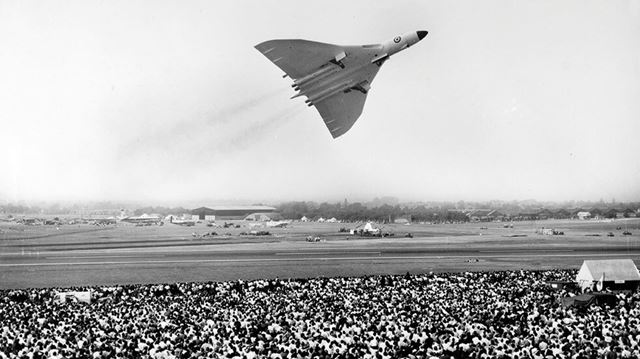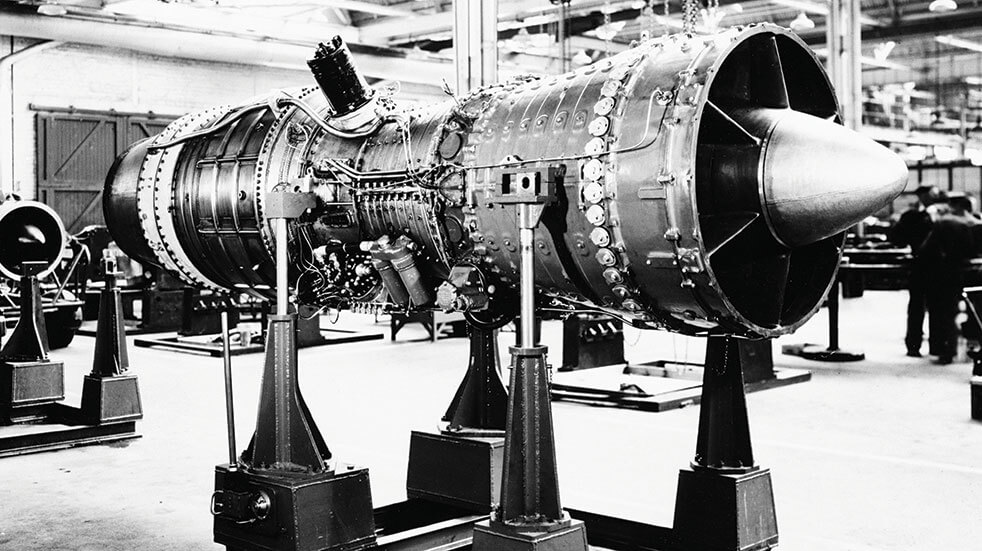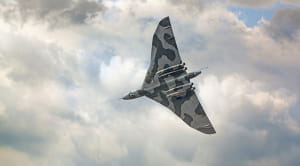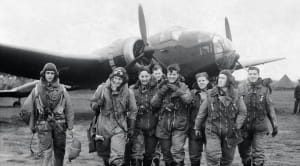
From a Met Office weather forecaster to ground engineers, discover more stories of Brits involved in the early days of the record-breaking Vulcan aircraft
Our article on the history of the Vulcan prompted Boundless members to get in touch with their own experiences, with more details of the early days of the plane’s development.
Early memories of the Vulcan
I was pleased to read the article in Boundless about the iconic aeroplane the Vulcan, as I did my National Service from 1951-53 and was stationed at Boscombe Down (The Aircraft & Armaments Experimental Establishment) for most of this time.
However, I was surprised to read that it only became part of the RAF in 1956. The Vulcan, along with the other V bombers, Valliant and Victor, all made their proving flights from this airfield. The Victor was in fact built under wraps at Boscombe Down as the De Havilland airstrip was not long enough for it to take off.
But it was the Vulcan (698) that everyone admired. For some weeks we had the spectacle of seeing it swooping and diving in the sky above us. I shall never forget the excitement that it created. In fact, one day I saw it sitting outside a hangar as I was walking to Station HQ, so I went up to it and stroked it without anyone challenging me!
Maybe it is right that it was not formally taken over by the RAF until 1956, but it was certainly very much part of the scene as far as I was concerned, in 1952.
Peter Bridgman, AC11
The Vulcan in competition
Reading the article about the Vulcan bomber reminded me of the time I played a small part in their operations. In the 1970's there was an ongoing competition between the RAF Vulcans and the USAF Strategic Air Command's B52's. This was called Exercise Giant Voice and alternated between the spring in the UK and autumn in the USA when these aircraft would fly a Bombing and Navigation competition.
Basically the crews were tasked to a) fly a high level 1000 mile route using Astro-Navigation to simulate the loss of electronic aids and b) a Hi-low-Hi level sortie. "Bombs" would be dropped and the accuracy would determine who won a trophy, whose name I forget.
For some years the Yanks won the competition easily but then in 1974 someone at Bomber Command HQ No 1 Group at RAF Bawtry had a brainwave, especially about the high level part. If the crews had really good forecasts of the high level wind patterns this might improve their accuracy. So they decided to take a weatherman along with them on their next visit to the USA - after all, he would not need a load of equipment, just a few pencils.
And it just so happened that I was stationed at the Met Office outpost at RAF Bawtry and was picked as the man to go. I spent a week at RAF Waddington meeting the crews and learning about their meteorological requirements and was invited to take a familiarisation flight in the Vulcan on one of their training sorties. This was not as exciting as it sounds. One is stuck in this cramped cubicle with three other guys and no windows. The pilot and copilot sat up in their lofty cabin on an upper level, accessible up a ladder. If I climbed up the ladder I could just about see out of the top half of the windshield but of course there was nothing to see.
Apart from the time when we did a practice emergency descent from 40,000 ft down to 10,000 ft in about one minute it was nearly five hours of boredom for me. The lucky crew had plenty of work to do though and lots of instruments to monitor.
The support personnel including myself and pencils flew out to Orlando Florida, via Gander Newfoundland, where we were to be based for almost the next five weeks on the military half of the airport. The four competition aircraft flew out directly a couple of days later and I have a lovely picture of them arriving in formation over the orange groves.
The guys from SAC were really good hosts and very friendly. Not many of them knew much about the Vulcan and its performance. In the ops room they were taken aback by the flight plans, which usually showed the usage of a mere 5000ft or so of the 10000ft long runway on take-off. Quite a few got caught out and it cost them real money when they had a bet with our boys that we couldn't do it in that space.
I was welcomed by the staff of the USAF Weather team who kindly allowed me the use of a desk in the corner, and more importantly access to their met communication channels.
This was in the days before the computer forecasts had really got going and I had to work out a method of making the upper wind forecasts almost from first principles. It took a lot of work with having to plot my own charts but eventually I worked out a routine and was able to give a full briefing before each flight. At the end of the detachment I did a check on the accuracy of my output and it seemed like I was getting within 10 degrees of direction on the winds and about 20 knots on the speeds over these 1000nm legs.
We had a break about a week before the competition started in earnest and the team had been invited to attend a small airshow at a local airfield. I vividly remember standing in the middle of a bunch of Americans while our Scottish piper - isn't there always one available? - entertained the crowd with some stirring music. And as the final drone faded away one of the Vulcans came in across the airfield at about 500ft altitude and pulled up into one of those climbing turns which showed off the silhouette so beautifully and he turned on the taps to produce that sound that only the Vulcan can make.
I heard an awed voice saying in a typical American drawl “Gee, I'm glad these guys are on our side”.
Once the competition got underway we found that we were really doing well on the high level section. Then we went into the Hi-Lo-Hi phase, which included a descent from up over East Texas and a low level run into Louisiana, thence across the Gulf of Mexico to come ashore on the West coast of Florida to a low level target and then home. I remember that the RAF had been a little worried that the radar navigation equipment, which needed ground returns, would have problems over the smooth sea waters but in the event there were enough oil rigs scattered around to provide the needed waypoint markers.
At the end of the competition honours were about even so we flew home reasonably satisfied. The brass at Bomber Command must have also been satisfied that I had contributed enough to warrant my passage so the next year I was asked to do the same job.
This time the competition was scheduled for later in the year and we flew out in the first week of December, normally well after the end of the hurricane season. However a late disturbance was hovering near Puerto Rico and the Miami Hurricane Centre had produced various forecast, which brought this up into Florida. There was talk of moving the competition up to Omaha Nebraska. Our detachment Wing Commander popped into my "office" in the USAF weather centre and I was able to re-assure him that, although I was not a hurricane expert, it seemed to me that there would not be a problem. So we carried on with our practice sessions and I was quite relieved when the damp squib moved away into the Atlantic.
This year the F111, SAC's latest shiny new bomber aircraft was now in service and they had been invited to the party.
All went fairly normally during the first high level phase of the competition with honours more or less even. However, although things had gone OK in practice, on the competition day the route across Florida had been changed to come over a patch of ground that contained some minerals or something that completely screwed up the mapping radar system on the Vulcans - this system was called Green Satin if memory serves. Anyway, it meant that some of our aircraft were unable to "bomb" the final target with accuracy and it cost us dear. Needless to say the F111s with their newer kit had no problems and promptly cleaned up the competition.
The following year, the MOD was finally stung into action and provided some new kit for the Vulcans who then went on to win the competition. Sadly I had been posted to the civilian side of the met Office and was not there to share in the triumph.
Alan A. Brown, retired Met Office forecaster
Read more about the Avro Vulcan and the history of the RAF
The history of the Avro Vulcan aircraft
Boundless members' memories of World War II
The role of the RAF in World War II
Witnessing the Vulcan air displays
Your article on the Avro Vulcan in the November/December issue stirred the memory pot.
When I was a nipper, in the late fifties/early sixties, my father took me to the annual air displays at RAF Finningley, now Doncaster/Sheffield (Robin Hood) airport.
As it was then an operational V-bomber base the display opener was a Vulcan scramble involving four aircraft. The aircraft were parked on the readiness hard standing at the end of the runway with their engines idling and then a flare was fired from the control tower. The first aircraft would then be throttled up, turned onto the runway and begin its take-off run.
The second aircraft would then be positioned at the end of the runway but would hold its position until the first aircraft’s wheels had left the ground before commencing its run. The third and fourth aircraft would repeat the procedure until all four aircraft could be seen climbing away on slightly different headings trailing their characteristic soot trails.
With sixteen Olympus engines at full cry the ground shook, along with the crowd's innards as the barriers were a lot closer to the runway in those days.
Ian J Plant
The first Avro Vulcans were powered by four Bristol Siddeley Olympus 101 turbojet engines.
The RAF ground engineers’ role
Having read the details of the forthcoming Vulcan event at Duxford I am again disappointed that no mention of the ground engineers' contribution is made. The aircraft did not get airborne just because the pilot pushed the throttle forward.
I served at RAF Waddington as a ground engineer when the Vulcan first entered service in 1956, later returning as a flight commander in second line servicing. A further posting took me back to Waddington as the senior engineer of 44(R) squadron.
Following this I moved to HQ Strike Command as the delegated engineering authority for the Vulcan, which included the Falklands war. I know from personal experience the hard work and dedication the ground engineers put into getting aircraft airborne and they should be duly recognised for the importance of their role.
Sqn Ldr Peter Holman, RAF (Ret'd)
The Vulcan’s retirement at the Imperial War Museum
I joined the then CSMA shortly after starting my employment with the Imperial War Museum at Duxford in 1981 and well remember when XJ824 flew into Duxford on 13 March 1982. As Curator of Aircraft, she with the rest of the IWM collection, was my responsibility.
I enjoyed Patrick Kinsella’s article on the Vulcan but have to correct one point. Three companies were given contracts to build what became known as V bombers; Vickers, Avro and Handley Page. The Vickers Valiant, although not as advanced as the others, was not a contingency design as 107 were built and served with the RAF until 1965. The contingency design was the Short Sperrin, of which only two were built in case the other three advanced swept wing designs were delayed or unsuccessful.
Patrick refers to the maiden flight of the prototype Vulcan VX770. Sadly as a 16 year old, I saw that aircraft crash at RAF Syerston during the 1958 Battle of Britain Air Show. It was then being used by Rolls-Royce at Hucknall (where 10 years later I was employed) as a flight test bed for RR Conway jet engines.
Thank you for bringing back both good and sad memories.
David W Lee IEng, MRAeS
Images © Getty





